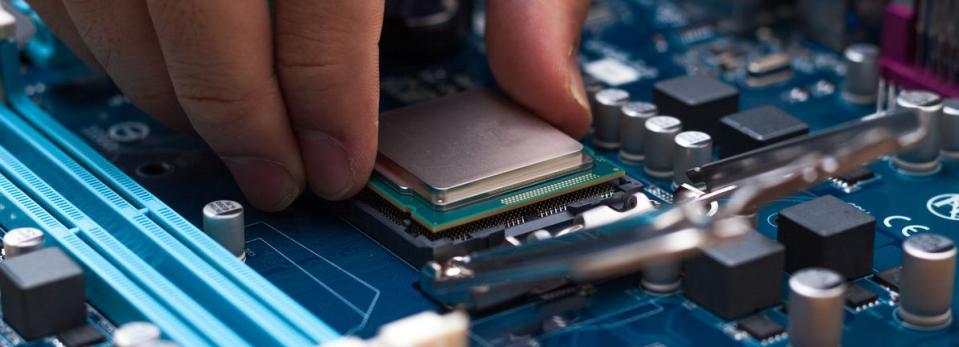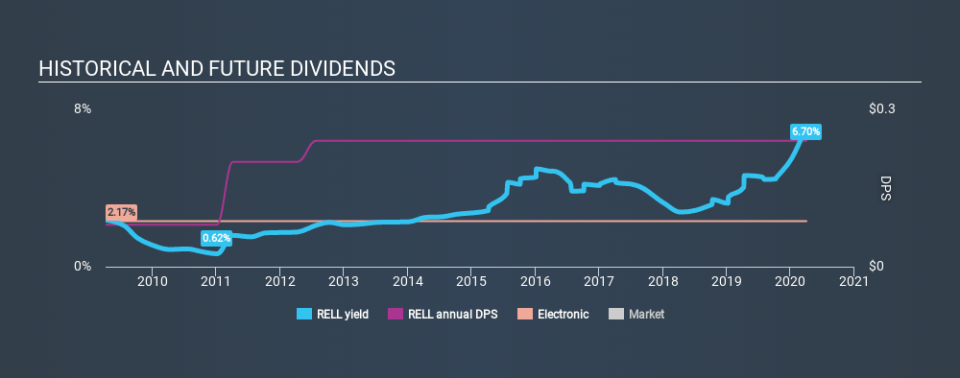Key Things To Watch Out For If You Are After Richardson Electronics, Ltd.'s (NASDAQ:RELL) 6.7% Dividend

Today we'll take a closer look at Richardson Electronics, Ltd. (NASDAQ:RELL) from a dividend investor's perspective. Owning a strong business and reinvesting the dividends is widely seen as an attractive way of growing your wealth. Yet sometimes, investors buy a popular dividend stock because of its yield, and then lose money if the company's dividend doesn't live up to expectations.
In this case, Richardson Electronics likely looks attractive to investors, given its 6.7% dividend yield and a payment history of over ten years. It would not be a surprise to discover that many investors buy it for the dividends. Remember though, given the recent drop in its share price, Richardson Electronics's yield will look higher, even though the market may now be expecting a decline in its long-term prospects. Some simple research can reduce the risk of buying Richardson Electronics for its dividend - read on to learn more.
Explore this interactive chart for our latest analysis on Richardson Electronics!
Payout ratios
Dividends are typically paid from company earnings. If a company pays more in dividends than it earned, then the dividend might become unsustainable - hardly an ideal situation. Comparing dividend payments to a company's net profit after tax is a simple way of reality-checking whether a dividend is sustainable. While Richardson Electronics pays a dividend, it reported a loss over the last year. When a company is loss-making, we next need to check to see if its cash flows can support the dividend.
Unfortunately, while Richardson Electronics pays a dividend, it also reported negative free cash flow last year. While there may be a good reason for this, it's not ideal from a dividend perspective.
While the above analysis focuses on dividends relative to a company's earnings, we do note Richardson Electronics's strong net cash position, which will let it pay larger dividends for a time, should it choose.
Remember, you can always get a snapshot of Richardson Electronics's latest financial position, by checking our visualisation of its financial health.
Dividend Volatility
From the perspective of an income investor who wants to earn dividends for many years, there is not much point buying a stock if its dividend is regularly cut or is not reliable. Richardson Electronics has been paying dividends for a long time, but for the purpose of this analysis, we only examine the past 10 years of payments. During this period the dividend has been stable, which could imply the business could have relatively consistent earnings power. During the past ten-year period, the first annual payment was US$0.08 in 2010, compared to US$0.24 last year. Dividends per share have grown at approximately 12% per year over this time.
Dividends have been growing pretty quickly, and even more impressively, they haven't experienced any notable falls during this period.
Dividend Growth Potential
Dividend payments have been consistent over the past few years, but we should always check if earnings per share (EPS) are growing, as this will help maintain the purchasing power of the dividend. It's good to see Richardson Electronics has been growing its earnings per share at 17% a year over the past five years. A company paying out less than a quarter of its earnings as dividends, and growing earnings at more than 10% per annum, looks to be right in the cusp of its growth phase. At the right price, we might be interested.
Conclusion
To summarise, shareholders should always check that Richardson Electronics's dividends are affordable, that its dividend payments are relatively stable, and that it has decent prospects for growing its earnings and dividend. Richardson Electronics's dividend is not well covered by free cash flow, plus it paid a dividend while being unprofitable. We like that it has been delivering solid improvement in its earnings per share, and relatively consistent dividend payments. In sum, we find it hard to get excited about Richardson Electronics from a dividend perspective. It's not that we think it's a bad business; just that there are other companies that perform better on these criteria.
Market movements attest to how highly valued a consistent dividend policy is compared to one which is more unpredictable. Meanwhile, despite the importance of dividend payments, they are not the only factors our readers should know when assessing a company. For example, we've picked out 4 warning signs for Richardson Electronics that investors should know about before committing capital to this stock.
Looking for more high-yielding dividend ideas? Try our curated list of dividend stocks with a yield above 3%.
If you spot an error that warrants correction, please contact the editor at editorial-team@simplywallst.com. This article by Simply Wall St is general in nature. It does not constitute a recommendation to buy or sell any stock, and does not take account of your objectives, or your financial situation. Simply Wall St has no position in the stocks mentioned.
We aim to bring you long-term focused research analysis driven by fundamental data. Note that our analysis may not factor in the latest price-sensitive company announcements or qualitative material. Thank you for reading.

 Yahoo Finance
Yahoo Finance 
